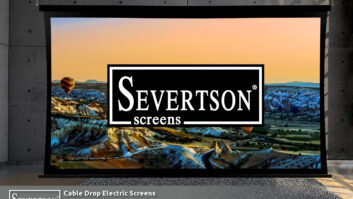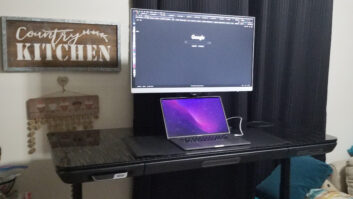In applauding his industry’s accomplishment of selling more than 2.5 million digital television products into the marketplace, CEA president Gary Shapiro said progress is at last being made in getting multi-industry involvement in furthering the DTV transition process. But, he called on the cable industry to address its compatibility issues.
“The DTV transition is not just about broadcast anymore,” Shapiro told attendees at the CEA’s recent DTV Summit, adding that multimedia high-resolution video sources, including DVD, video games, satellite TV and most recently cable TV, have joined with more digital broadcasts in giving consumers a reason go digital.
But Shapiro used the introduction to Charles Dickens’ “Tale of Two Cities” to assess the transition from both the commercial and political fronts. Politically, the transition remains hung up on “the 2 C issues:” cable compatibility and copy protection, he said.
Shapiro lamented the fact that while 70 percent of Americans get television service through cable, fewer than 15 markets in the country have HDTV programming carried by the local cable company.
While FCC Chairman Michael Powell’s recent plan for the DTV transition addresses cable carriage, “it overlooks the issue of cable compatibility,” Shapiro said. “Manufacturers believe strongly that these issues are absolutely critical to consumer adoptions of DTV and cannot afford to be overlooked.”
On copy protection, Shapiro said the CE industry is opposed to content providers who would require licensing agreements that nearly eliminate consumers’ rights to home recording and severely threaten product interoperability.
Despite the differences, Shapiro said his industry is against a government-mandated timetable to reach multi-industry resolutions.
“These issues are much too important for a shot-clock approach,” he said. “Our industry looks forward to continuing private-sector discussions such as the Copy Protection Technical Working Group to work through the remaining obstacles.”
Regarding HDTV programming, Shapiro said it is time for broadcasters, manufacturers and cable and satellite providers to “emphasize the H in HDTV.” He pointed to CEA consumer research that shows more awareness of high-definition television than to the term “digital television” (DTV).
Shapiro released CEA March factory-to-dealer unit sales numbers of DTV products showing total sales of 148,369 units, representing an 86 percent increase compared to the same period in 2001, and total dollar sales of more than $257 million.
He attributed the number to “manufacturers making it easier than ever for consumers to take advantage of the slow, but steady increase of HDTV programming with a wide variety of product choices and lower prices.”
He also pointed to expanded HDTV programming choices in the past year, including CBS’s HD coverage of the NCAA Basketball Tournament and Masters Golf Tournament; and NBC’s and HDNet’s broadcasts of the Winter Olympics as examples of the content that will drive the transition further.
CEA also reported DTV product sales (integrated sets and displays) to date in 2002 represent the strongest first quarter start in DTV history, totaling 431,424 units — an 84 percent increase over the first quarter of 2001. Dollar sales totaled $767 million, or a 66 percent increase over the same period in 2001.
CEA projects that 2.1 million DTV products — including integrated sets and displays — will be sold in 2002; 4 million in 2003; 5.4 million in 2004; 8 million in 2005; and 10.5 million in 2006.
Sean Wargo, CEA senior industry analyst, offered results of consumer studies. To better understand the DTV buyer segments, the study used a Web-driven survey focused on Internet users, who are viewed by CEA to be “the most sympathetic to digital products,” and hence “a population of likely buyers,” Wargo said.
Among the 1,205 respondents, 29 percent said they definitely or probably would make their next TV purchase an HDTV, while 21 percent definitely or probably would not. Forty-eight percent fell in between.
Wargo said the study indicated there are approximately 8 million “short-term likely buyers” in the U.S. who are likely to purchase an HDTV within the next 18 months. Added to that are 15 million short-term potential buyers who may or may not purchase an HDTV in the next 18 months.
“That is encouraging news that suggests a product that is not stalling in the market place, but that has a solid base of interest out there,” Wargo said.
Wargo said the short-term likely buyer remains “an early adopter who owns a variety of technology,” including home theater and satellite and who is less likely to have purchased a TV within the past two years. This indicates a large consumer group that is watching and waiting for the next technology, he said.
Moving out along the adoption curve, he said, the more you get into the mainstream consumer segments. The survey found that 25 percent of overall potential buyers are likely to be early adopters versus 42 percent of short-term HDTV buyers.
In analyzing why these consumers had not yet made an HDTV purchase, most listed cost as the prohibiting factor and the need to purchase additional equipment as another major consideration.
On the content side, respondents expressed a willingness to shift between cable and satellite TV providers in order to get more HDTV content. Some 71 percent said they were very/somewhat likely to switch TV services for more HDTV content, while 21 percent said the might switch and another 21 percent said they were not very or at all likely. Among the consumer segments, 84 percent of short-term likely buyers were likely to shift providers, and 65 percent of potential buyers were likely to switch.











